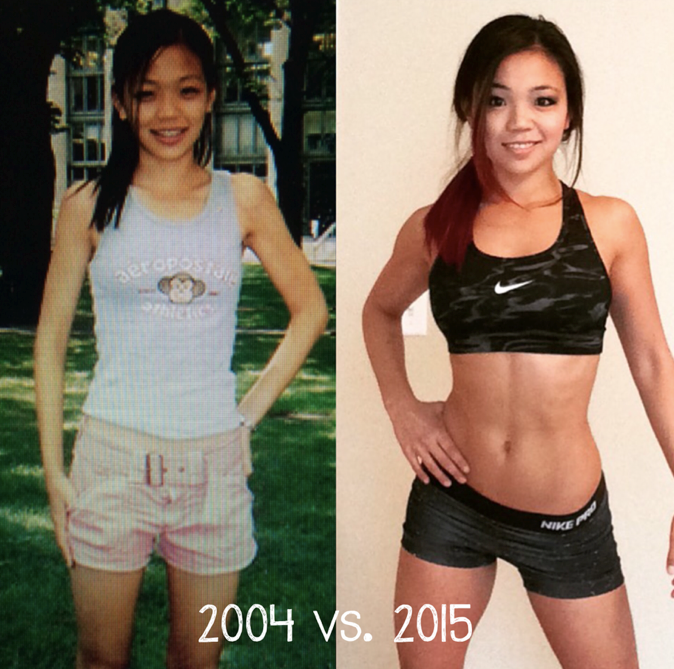When “Just Lose More Fat” is Not the Answer
“I just want to be toned.”
“I need to lean out for the summer.”
For women in particular, slashing calories and swearing off bread forever seems to be the default reaction to wanting a supposed bikini body.
There is nothing inherently wrong with wanting to drop bodyfat – let me be clear on that. If you want to lean out, all the more power to you.
But before you move forward with dieting, it’s important to understand that “just lose more fat” is not always the answer to your physique woes. In other words, the body that you’re after – that “toned,” athletic yet slender look – may not necessarily be a simple matter of shedding fat off your frame.
What do I mean by this?
You may not want to diet if:
1.) You’re skinny fat.
Your bodyweight is considered healthy according to the BMI scale, yet your body fat percentage is still high – this is typically manifested in the form flabby arms, flabby legs, and probably a doughy midsection that refuses to go away no matter what. In other words, you simply don’t have much lean muscle mass on your frame, which in turn makes it more difficult to see any muscle definition.
Muscle definition is good.
Oftentimes, people find themselves looking skinny fat if they’ve been focusing solely on scale weight. I don’t condone this approach for several reasons, one of which includes the fact that it completely disregards body composition. At the same time, fear of seeing the number on the scale go up can prevent you from building quality muscle that will actually help you achieve the look that you’re going for.

People usually get here via a combination of long-term caloric restriction, excessive cardio, and avoidance of weight-bearing exercises.
If you fall into this category, then you may want to hit the brakes on dieting – for now, anyway.
2.) You’ve been crash dieting for a considerable length of time.
In this case, your body has likely long since stopped responding to what should be a caloric deficit.
And if this is you, then no amount of cardio or sad lettuce-eating will get your body to drop fat. You may be religious about getting in your gym sessions, drinking your water, nailing your nutrition, and managing your stress levels — in other words, doing all the right things for fat loss — but none of that will matter if your body is pissed off.
We all know that I’m not a proponent of crash dieting. It only works until it doesn’t, and then the aftermath is typically incredibly messy. It’s not unusual to regain the weight that was lost during the crash dieting phase plus more. Why? In a nutshell, because the methods utilized were not sustainable.
(Are there exceptions? Yes, there are a handful of people who can successfully crash diet and then keep that weight off over the long term. If this is you, all the more power to you. But please, don’t count on being the exception. That’s how you get yourself into trouble.)
How do you know if you’ve been crash dieting? In general, your calorie intake has been somewhere in the (10-12) x (bodyweight in lbs) range or lower, and you can’t remember the last time you haven’t been trying to diet. On top of that, your qualify of life has likely gone down the drain, you may be obsessed with the scale weight, and you might be terrified of carbs. Or fats. Or both.
3.) You’re already lean with some, but not much, muscle mass.
This is perhaps the fuzziest category to pinpoint. After all, what qualifies as “lean”? What counts as having “some” muscle mass?
Let’s use myself as an example.
Back in 2008, I had just discovered weightlifting. In January, I was 5’2″ 110lbs with some muffin top going on (yes, really!). Unfortunately I don’t have any progress pictures from that time, but over the next few months, I dropped 8lbs. Here’s what my body looked like by June:

I managed to get myself pretty lean, as you can see. I didn’t have any extra flab, I’d gotten rid of the rolls around my waist, and when I flexed, you could see a sixpack. I’d estimate my bodyfat to have been around 16% or so.
Strength-wise, I wasn’t doing too terribly for a beginner weightlifter. After less than six months of teaching myself how to lift, I was deadlifting 90lbs, squatting 85lbs, and dumbbell bench pressing 30lbs in each hand. I hadn’t yet built up the strength to do a full bodyweight pull-up just yet, however.
It was during this time that I hired an online coach and told him that I wanted to lose even more fat. He agreed to help.
Now, you may be thinking to yourself, Lose more fat? From where? And looking back, I can certainly attest to the fact that I definitely should not have been continuing to diet. With my calories already in the 1,300 range and my steady-state cardio at 45 minutes a day, four days a week, I hadn’t left myself with much wiggle room to make progress.
I didn’t really get anywhere over the next six months (surprise!). Yes, I got a tiny bit stronger, and yes, my conditioning improved, but my calorie allotment was so low (started out at 1,200 and ended at just under 1,000) that I was essentially running on fumes. As well, over time, my cardio was gradually bumped up to six days of 45-minute steady-state sessions per week – all of this in addition to four days of weight training. I was moving a lot and eating very little, in other words.
That program turned out to be the perfect recipe for a rebound. Once my bodyweight hit 99lbs — and some simple math will tell you that I lost a measly half pound per month — I had so depleted my willpower that my eating spiraled out of control, and I proceeded to pack on 20+ pounds over the next two months. The kicker? Nobody had noticed or even cared about the 3lbs that I’d dropped. Oh, and I was miserable.
Here’s what should have happened: Despite my desire to achieve that ripped, shredded look, my coach at the time should have recognized that I had neither the muscle mass nor the caloric flexibility to try to continue to lean out. At best, I would have listened to him and switched to a slow muscle-building phase; at worst, he should have refused to work with me had I insisted on dieting. As it were, neither of those scenarios unfolded, and I was left to struggle with the repercussions over the next four years.
Hot damn.
Ladies, if your bodyfat is already under 20% (men under 12%), you’re considered pretty lean already. If you want to shed a few more pounds of fat, that’s probably okay. But once you near 15% (men 9%), you’re reaching the land of diminishing returns: lots and lots of work and hurting for fewer and fewer gains.
Build a fit, lean look with the following steps:
1.) Pull yourself out of a caloric deficit.
I understand this can seem scary. After all, you may know nothing but dieting non-stop year-round.
However, what many individuals – women in particular – may struggle to grasp is the fact that having more lean muscle mass actually makes you look better. It gives you the shapely curves that you’re going for – provided that it’s not covered by a thick layer of fat, of course. And consuming enough food will ensure that your body is provided with the energy it needs to build said muscle.
I’m not saying that you should become Ben & Jerry’s next best customer. The point is not to swing wildly from one extreme to the other.
All you need to do is to not be in a caloric deficit. For some of you, that may mean adding in an extra 300 calories per day. For others, that may look more like 500-800.
In general, maintenance calories for people tend to be in the (14-16) x (bodyweight in lbs) range. This number can be influenced by genetics, age, dieting history, and lifestyle factors, but most people will be able to hang out here comfortably. The formula isn’t perfect, of course, but it’s a good ballpark estimate.
If I’m a 25 year-old female who is lightly active during the day and has not been dieting for the past six months, my maintenance calories may be calculated to be on the higher end of the range at just above 1,700 calories.
2.) Consume sufficient protein.
Protein is king! That much is clear.
Protein not only helps you build muscle, but it also helps retain it. And while the RDA sits at 46 grams per day for a 57.5kg woman and 56 grams per day for a 70kg man, remember that these recommendations are for sedentary individuals – and we’re not sedentary, right?
When you throw strength training into the equation, protein requirements increase. Why? Because muscle protein breakdown rates increase, and you need to overcome that via dietary intervention.
It makes sense, then, that if you want to build muscle (and you do want to build muscle), then you should be making protein a priority.
Recommendations for active individuals will vary across the board. I’ve seen coaches prescribe anywhere between 0.8-1.2 grams per pound of total body weight.
As a general rule of thumb, I like to keep my intake at 1.0 gram per pound of total bodyweight at the bare minimum.
3.) Start weight training for strength.
Remember: Muscle is good. Strength is good.
When it comes to weight training, anywhere between two to four days a week is a solid starting point, depending on the individual. For most people, I’d recommend either a full body split or an upper/lower split. Doing so will allow for increased opportunity to work given muscles.
Of course, you’ll want to prioritize compound movements such as squats, deadlifts, pullups, and bridging variations. Women in particular may want to place special emphasis on their glute development by working them more frequently.
By “weight training for strength” I mean that you should be striving to make progress from one week to the next. Take each session seriously. Do your warmup and focus on the exercise rather than gossip with your girlfriend in the middle of your set.
Progress can mean you add an extra 5lbs onto your squat, or perhaps it means that you stay at the same weight but squeeze out an extra rep. It can even mean that your form improves slightly – that still counts as progress!
If you’re looking for a quality training program, I’ve written a two-day split for you here and a four-day split for you here.
4.) Give it time.
It’s easier to be impatient; we’re accustomed to instant gratification. I totally get it.
But if you want to build a solid foundation of muscle and look more athletic (and leaner!) in the long-term, you have to give it time.
A scant two months at what you’ve calculated to be your maintenance intake before diving straight back into a steep caloric deficit isn’t going to cut it. I know the temptation may be there – because maybe you have this lingering fear that if you’re not chronically dieting, then you’re going to gain 20lbs overnight – but I encourage you to stick with it.
Building a physique takes time. It takes months and years of hard work and dedication. And if you’re too busy cutting calories left and right, you’re never going to give your body a fighting chance.
In general, the longer you’ve been dieting, the longer you should be out of a caloric deficit.
Again, that doesn’t mean that you have to bulk or pile on tons of fat. If you want to reverse diet, you can certainly do that. If you’d prefer to simply eat enough and keep your calories stagnant for a while, that’s fine, too.

Here’s a before and current side-by-side of myself to show you what can be achieved.
On the left, I’m 14 years old and anorexic. In that picture, I’ve already lost over 20lbs off of my already-small 5’2″ frame and I’m hovering right around 80lbs. I’m eating exactly zero calories per day plus running 15 miles and doing 300 pushups and 5,000 sit ups every single day. I’m not lifting any weights out of fear of getting bulky – and yet I’m wondering why I don’t look the way I want.
On the right, I’m 25 years old and I have over seven years of strength training under my belt. I’m still 5’2″ (unfortunately) and my weight is at 108lbs. I’ve followed the four basic principles above for long enough to see positive change take place in my physique. As I write this, I can squat 160lbs, bench press 105lbs, and deadlift 215lbs.
I look much healthier and athletic now if you ask me. (Not to mention, I’m far happier.)
Learn to enjoy the ride.
If you’re in this to make a long-term, lasting lifestyle change, then I encourage you to take the focus off the scale weight.
If I’d never let go of my obsession with staying below 90lbs, I never would have known what it felt like to be strong. I never would have allowed myself to build any muscle. I would have stayed petrified of any and all food, and hell – maybe I never would have made it here.
Fitness is about so much more than how much you weigh.
Ladies in particular: I urge you to set performance goals in the gym. Shoot for one strict bodyweight pullup. Train for a powerlifting meet (that’s what I’m doing now!). Learn a new skill, such as how to double clean kettlebells.
Doing so will allow you to feel truly empowered, and you’ll learn that true fitness success comes when you fall in love with the process and enjoy the ride.
There’s a lot to be said about consistency, both with training and with nutrition.
Stick to the four basic principles outlined above and your body will be thanking you for many years to come.





